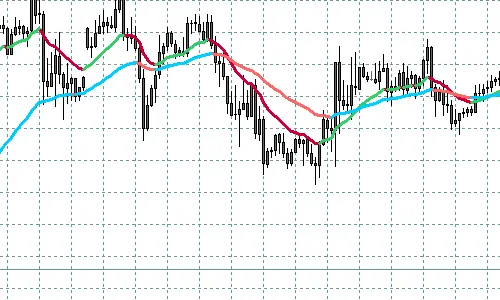期货量化交易软件:交易者的工具箱设计指标
简介
什么是指标? 指标是显示特定数据类型的指定工具。 通常这是关于价格系列属性的信息,赫兹量化正是会对这种指标类型做进一步的讨论。
每个指标还拥有自己的属性和特性:例如,值的范围,超买/超卖区间,交叉线、顶部和底部... 这些大量的属性可连续地与主指标值共同使用。 但是,这些属性并不总是有效。 有多种原因 - 指标窗口过小,低密度等。
本文目的旨在协助你改善描述性和信息性的指标值,以及促进代码实施过程的部分自动化和简易化。 我希望以下的代码对专业开发人员和新手都不会造成困难。
本文主要面向的人群需至少拥有 赫兹量化入门水平知识,可以在代码中实施简单想法和算法,了解终端内的代码存储架构,并且可以使用库(experts/libraries)和头文件(experts/include)。

编辑切换为居中
1. 设置一项任务
所有指标中,我想要列出最具信息性的常用指标:
交叉线。
编辑
水平 - 不仅是交叉点的水平,整个水平都将高亮。
编辑
顶部/底部为简单说明。
编辑
上行/下行方向使用不同配色。

编辑
赫兹量化来对其进行讨论。
2. 基本概念
为避免误解,赫兹量化花些时间来查看指标架构。
#property indicator_separate_window // number of visible buffers of the indicator #property indicator_buffers 3 // setting the range of indicator values #property indicator_minimum 0 #property indicator_maximum 100 // setting indicator colors #property indicator_color1 White #property indicator_color2 Red #property indicator_color3 Blue // external settings extern int RSIPeriod = 9; extern int AppliedPrice = 0; extern int MAPeriod = 5; // declaring indicator buffers. Here they can be declared in any order. // Any names can be given to buffers, though better meaningful double Values[]; // Values double SmoothedValues[]; // Smoothed values double Crosses[]; // intersections // Significant number of digits after a decimal point in indicator values int DigitsUsed = 5; // Used empty value. In MQL4 there are two empty values -- EMPTY (-1) // -- used as an empty parameter when calling functions // EMPTY_VALUE (0x7FFFFFFF) -- used as an unacceptable value // (or default value) of a variable in indicators and function calls. // The fact is, most built-in indicators return 0 if there is no value // Besides, in custom (iCustom) indicators the empty value can be // set as any, this must be noted. int EmptyValueUsed = 0; // Initialization function. int init() { // Number of used buffers can be larger than that of displayed ones; some // may contain intermediate calculations and additional information. The total // number of buffers including additional ones is displayed here. // If there are no additional buffers, // this line is not needed. Total number must not exceed 8 // IndicatorBuffers(3); // associate buffers. Indexes must go from 0 till the declared number (not including) // buffers are drawn in the order of index growing, this is important and can be // used when righting indicators further. // It means that a buffer with a larger index is drawn above the buffer with lower one SetIndexBuffer(0, Values); SetIndexBuffer(1, SmoothedValues); SetIndexBuffer(2, Crosses); // besides, it is important that additional buffers are located after displayed ones // (i.e. they must have higher index) otherwise problems may occur displaying buffers, // and sometimes the error can be hardly found // This function sets an empty value for the buffer with the preset index // I do not recommend to use this function in order to avoid possible difficulties // Default empty value for buffers -- EMPTY_VALUE. // Empty buffer values are not drawn in a chart (except for DRAW_ZIGZAG) // SetIndexEmptyValue(0, EMPTY_VALUE); // Set parameters for buffers SetIndexStyle(0, DRAW_LINE); // The main signal is a solid line SetIndexStyle(1, DRAW_LINE, STYLE_DASH); // Smoothed -- dotted line SetIndexStyle(2, DRAW_ARROW, STYLE_SOLID, 2); // Intersections -- crosses of the size 2 SetIndexArrow(2, 251); // cross code in Wingdings IndicatorDigits(DigitsUsed); // set number of significant digits after point // Setting the starting plotting point for each indicator. If in terms of the current index // the history depth // is lower than the value written here, the buffer value with this index will not be drawn. SetIndexDrawBegin(0, RSIPeriod); SetIndexDrawBegin(1, RSIPeriod + MAPeriod); SetIndexDrawBegin(2, RSIPeriod + MAPeriod + 1); return(0); } int start() { // counting number of bars for re-calculation int toCount = Bars - IndicatorCounted(); // Calculating values // counting from history start till the current moment for (int i = toCount - 1; i >=0; i--) { // I understood its convenience only when I started to use it // I recommend to conduct the normalization of data at once, // so that later comparison could be easily made Values[i] = NormalizeDouble(iRSI(Symbol(), 0, RSIPeriod, AppliedPrice, i), DigitsUsed); } // Counting smoothed values for (i = toCount - 1; i >=0; i--) { SmoothedValues[i] = NormalizeDouble(iMAOnArray(Values, 0, MAPeriod, 0, MODE_EMA, i), DigitsUsed); } // ... return(0); }

